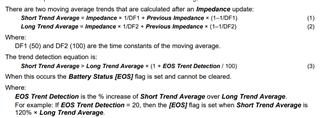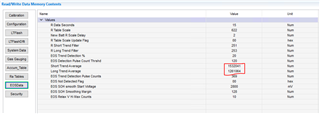Other Parts Discussed in Thread: EV2400
Hi,
I ran an accelerated test such that the battery (SAFT LS14500) drained in about 15 days. I noticed that the measured impedance value was at 32767 mOhm when EOS flag was set. I had stopped applying the load pulse (20 mA) at this point and allowed the battery to rest for a day. When I restarted the test, the measured impedance had gone down to a very low value, but within three measurements the measured impedance had exponentially climbed up and again hit a high of 32767 mOhm. Based on the TRM, the max. value this register can hold is 16 bits i.e. 65535, but in this case, it seems like it is only 15 bits. The scaled R value is also stuck at 20381, but then this is related to the measured Z value, which explains it. I verified that the value being read by my MCU is correct by comparing it with the value being read by EV2400. What could be happening here?
Regards,
ashare




